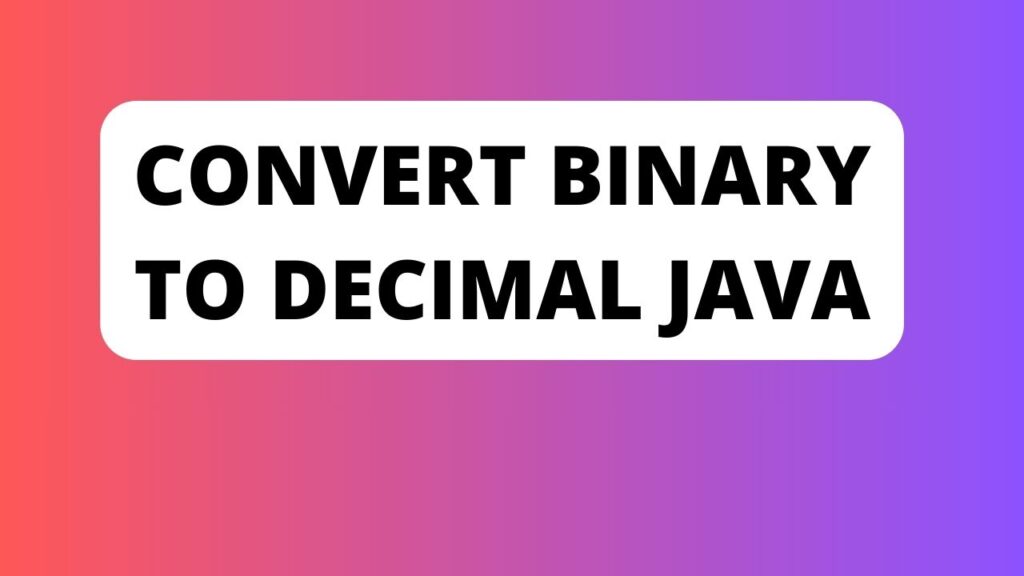Introduction
Convert Binary to Decimal Java The world of programming often revolves around manipulating data in different formats. One fundamental conversion process is translating binary numbers into their decimal equivalents. Understanding this process is pivotal in Java programming, considering its widespread use in various applications.
What is Binary to Decimal Conversion?
Binary to decimal conversion involves transforming binary numbers (base 2) into decimal numbers (base 10). Each digit in a binary number represents a power of 2. Converting these binary representations into their decimal counterparts is crucial in numerous programming scenarios.
Importance of Binary and Decimal in Programming
Binary and decimal representations serve as the backbone for data manipulation in programming languages. Their conversion is vital in computations, data storage, and various algorithmic implementations.
Java’s Role in Binary to Decimal Conversion
Java Programming Language Overview
Java’s robustness stems from its object-oriented approach and platform independence, making it an ideal choice for various applications.
Built-in Functions for Conversion
Java boasts built-in methods and functions specifically designed for seamless binary to decimal conversions, streamlining the development process.
Practical Examples
Binary to Decimal Conversion Walkthrough
Let’s delve into a step-by-step example, converting a binary number to its decimal equivalent using Java.
Real-life Java Applications
From data processing to algorithm development, the ability to convert binary to decimal in Java is fundamental. It finds applications in diverse domains, including finance, software engineering, and scientific computations.
Common Mistakes & Troubleshooting
Errors in Conversion Process
Debugging conversion errors involves meticulous scrutiny of the conversion logic, handling potential logical errors or incorrect implementations.

Debugging Tips in Java
Utilizing Java’s debugging tools, like breakpoints and stack trace analysis, streamlines the identification and resolution of conversion-related issues.
Best Practices
Optimal Coding Strategies
Follow best practices such as modularization and commenting to ensure readable and maintainable code.
Handling Edge Cases
Account for edge cases like handling negative binary numbers or extremely large values to fortify your conversion logic.
Basics of Binary
Understanding Binary Representation
In the binary system, numbers are represented using only two digits: 0 and 1. Each digit’s position represents a power of 2, showcasing the value of that position.
Binary Number System Explanation
Exploring the binary number system unveils its structure and how values are calculated based on the position of each digit.
Binary to Decimal Conversion Process
Algorithm for Binary to Decimal Conversion
A step-by-step breakdown of the algorithm used to convert binary numbers to decimals provides insight into the process.
Java Methods for Conversion
In Java, several methods and functions simplify the conversion process, streamlining coding tasks.
Java Basics for Binary to Decimal
Java Data Types Used in Conversion
Understanding the data types in Java crucial for binary to decimal conversion ensures accuracy in calculations.
Code Structure for Conversion in Java
An illustrative breakdown of Java code structures for effective conversion enhances understanding and implementation.
Practical Applications
Real-world Usage of Binary to Decimal Conversion
Exploring real-world scenarios where binary to decimal conversion is applied demonstrates its practical relevance in software development and beyond.
Examples in Software Development
Concrete examples showcasing how this conversion is integrated into software development projects.
Advantages and Challenges
Advantages of Binary to Decimal Conversion in Java
Highlighting the benefits of employing binary to decimal conversion in Java emphasizes its significance.
Challenges and Pitfalls
Recognizing challenges and potential pitfalls allows programmers to mitigate errors and optimize their code effectively.
Efficiency and Optimization
Optimizing Conversion Algorithms
Techniques and strategies for enhancing the efficiency of conversion algorithms in Java programming.
Java Techniques for Efficient Conversion
Specific Java methodologies and functions that optimize the binary to decimal conversion process.
Error Handling
Common Errors in Conversion
Identifying common errors encountered during binary to decimal conversion in Java provides insight into troubleshooting.
Exception Handling in Java
Effective error handling practices in Java that ensure seamless conversion processes.
Tips and Best Practices
Tips for Effective Binary to Decimal Conversion in Java
Practical tips and guidelines to streamline the conversion process and enhance code quality.
Coding Best Practices
Adopting coding best practices for clean, efficient, and maintainable code when converting binary to decimal in Java.
FAQs
- How does Binary to Decimal Conversion Work?
- Is Binary to Decimal Conversion Reversible?
- What are the Common Mistakes in Java Conversion?
- How to Handle Large Binary Numbers in Java?
- Can Binary Fractions be Converted to Decimal in Java?
- What Resources Help Improve Conversion Skills?
Conclusion
In conclusion, mastering the conversion from binary to decimal in Java is fundamental for programmers. This knowledge empowers developers to handle data efficiently, optimize code, and navigate potential challenges seamlessly.
